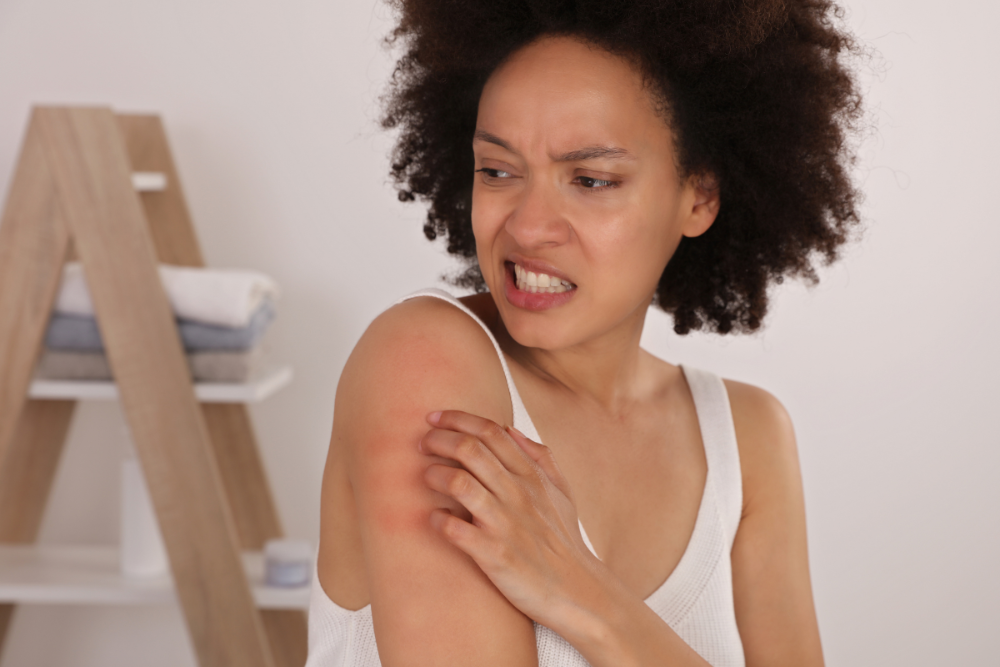Herpes symptoms can appear within 2 to 20 days after initial exposure to the virus in men, but the average incubation period is around 4 to 6 days. It’s important to note that some individuals may carry the herpes virus without displaying noticeable symptoms.
Delving into herpes onset in men, this article shares the timeframe between exposure and symptoms. If you’ve ever wondered, “How long does it take for herpes to show up in a guy?”— you’re not the first. Join us as we break down the process, offering valuable information for a proactive and informed approach to personal health.
Recognising Symptoms of Herpes in Men
Understanding and recognising herpes symptoms in men is essential for timely intervention and effective management. Some men may experience very mild symptoms, while others are more severe. Here’s a guide to help you identify the signs:
Unusual Itching or Tingling: The Initial Warning
Pay attention to sensations such as itching or tingling in the genital area. Unusual discomfort may be an early indicator that warrants closer observation.
Redness and Small Bumps: Visual Clues
Visual cues, like redness and the appearance of small, often painful bumps, can signify the onset of herpes. Regular visual checks can aid in early recognition.
Flu-Like Symptoms: Body’s Response
The initial stage might present flu-like symptoms such as fever, headache, and muscle aches. These signs shouldn’t be ignored and should prompt further investigation.
Pain or Discomfort During Urination: An Alert
Any pain or discomfort during urination should raise a flag. It could be associated with herpes, prompting the need for a closer examination.
Presence of Sores or Lesions: Visual Confirmation
The presence of sores or lesions in the genital region is a clear visual confirmation of herpes. Regular self-checks can aid in early detection.
Swollen Lymph Nodes: A Sign of Infection
Swollen lymph nodes, particularly in the groin area, can be a sign of infection. If persistent, consult a healthcare professional.
Recurring Symptoms: Patterns to Watch
If you notice recurring symptoms resembling herpes, it’s essential to track patterns. Documenting symptoms helps in providing comprehensive information to healthcare professionals.
By staying informed about these potential genital herpes symptoms and being proactive in seeking medical advice, individuals can take charge of their health and well-being. Remember, early recognition is key to effective herpes management.

Understanding Herpes Incubation Time: What to Expect
Navigating the timeframe between exposure and the onset of herpes symptoms involves a nuanced understanding of the incubation period.
Herpes incubation is a variable process, ranging from 2 to 20 days after exposure to the virus. This waiting period can test patience, but it’s essential to grasp the diverse timelines individuals may experience. Some may see symptoms emerge rapidly, while others might wait a bit longer.
Factors Influencing Incubation
Several factors can influence how quickly herpes symptoms appear, including the individual’s immune system, the specific herpes strain, and overall health. By recognising these variables, individuals gain a more informed perspective on their unique situation.
Early Warning Signs
In the initial days post-exposure, keep an eye out for early warning signs such as itching or tingling. These subtle sensations often serve as the prelude to the full manifestation of symptoms, providing a window for proactive measures.
Timeline of Herpes Onset: How Soon Symptoms Appear in Men
Curious about the clock ticking between exposure and the emergence of herpes symptoms in men? Let’s unravel the timeline:
The First Countdown: Incubation Period
The incubation period, averaging 4 to 6 days but ranging from 2 to 20 days, sets the stage. Understanding this initial outbreak countdown is key to anticipating when herpes symptoms might make their debut.
Early Whispers: Signs in the Early Days
As the clock ticks away, be on the lookout for subtle signs like itching or tingling. These early whispers are often the first clues that the herpes virus might be gearing up for its entrance.
Full Disclosure: Around the Two-Week Mark
Symptoms tend to fully unfold around the two-week mark. This is when you may experience visible sores, flu-like symptoms, and discomfort. Recognising this time frame provides insights for prompt actions and informed decision-making.
Find out – How long does a herpes outbreak last?
Cracking the Code: Factors Influencing Herpes in Males
Unlocking the mysteries of herpes manifestation involves understanding the factors that influence how symptoms appear in men. Let’s break the code:
Immune System Dynamics: The First Line of Defence
A robust immune system serves as the frontline defence against herpes, profoundly influencing the pace and intensity of symptom onset in men. The variability in individual immune responses plays a pivotal role, with a strong defence system mitigating the severity of outbreaks and potentially limiting their duration.
The distinction between the immune response during primary infection and subsequent recurrences further highlights the nuanced role of the body’s defences in shaping the overall timeline of herpes manifestation. Lifestyle factors, such as stress management, healthy habits, and proper sleep, also contribute significantly, underscoring the importance of a holistic approach to fortify the immune system.
Herpes Strain Variability: Not All Strains Are Equal
When it comes to herpes, there are different types, like HSV-1 and HSV-2. HSV-1 usually shows up as cold sores around the mouth, but it’s now also causing more cases of genital herpes infection. On the other hand, HSV-2 typically causes genital herpes with more frequent and severe herpes outbreak.
These differences matter because each type behaves a bit differently. They vary in how easily they spread, how often they come back, and the problems they can cause. Knowing which type you have helps in figuring out the best ways to deal with it and manage outbreaks. So, it’s not a one-size-fits-all situation with herpes—understanding these differences helps people make decisions that work best for them.
Overall Health Impact: A Holistic View
Herpes, whether herpes simplex virus-1 (oral herpes) or herpes simplex virus-2 (genital herpes), extends its impact beyond physical symptoms, influencing various aspects of overall health. The recurrent nature of outbreaks can disrupt daily life and intimate relationships, demanding a multifaceted approach for both prevention and management.
Beyond the physical discomfort, the emotional toll of herpes, exacerbated by societal stigma, can lead to feelings of isolation and stress. Adopting a holistic perspective involves not only addressing the immediate physical challenges but also prioritising mental and emotional well-being. Strategies encompassing open communication, healthy lifestyle choices, and consistent medical care contribute to a comprehensive framework for navigating the overall health impact of living with herpes, promoting resilience and a positive quality of life.
Genetic Factors: Unveiling Individual Susceptibility
Unravelling the complexities of herpes susceptibility involves delving into genetic factors that play a role in an individual’s likelihood of acquiring and experiencing outbreaks. While genes alone do not determine one’s fate with herpes, they can influence the body’s immune response and how effectively it combats the virus.
Certain genetic variations may affect the immune system’s ability to recognise and control herpes, impacting the frequency and severity of outbreaks. Understanding these genetic nuances is instrumental in personalising preventive strategies and herpes treatments. However, it’s important to note that environmental factors and lifestyle choices also contribute significantly to herpes outcomes, highlighting the intricate interplay between genetics and external influences in determining an individual’s susceptibility to this common viral infection.

Average Duration Before Herpes Symptoms Surface
In the realm of herpes onset, understanding the waiting game is paramount. Let’s explore the average duration before symptoms surface and what this waiting period entails:
Navigating Variability: The 4 to 6-Day Window
The average duration before herpes symptoms appear typically spans 4 to 6 days post-exposure. However, this timeframe can vary, emphasising the importance of recognising individual differences and the unpredictability of the virus.
Individual Clocks Ticking: 2 to 20 Days Range
While the average provides a general guideline, it’s essential to acknowledge the broader range of 2 to 20 days. Herpes doesn’t adhere to a one-size-fits-all schedule, highlighting the unique timelines each individual might experience.
Early Signals: Anticipating the Prelude
During this waiting game, be attuned to early signals such as itching or tingling. These subtle cues often serve as the prelude to the full onset of other symptoms like herpes lesions, offering an opportunity for proactive measures.
Preparedness Matters: Navigating the Unpredictable
Recognising the variability in the waiting game arms individuals with the knowledge needed to navigate the unpredictable nature of herpes onset. Stay prepared, stay informed, and take charge of your health journey.
Insights into Herpes Onset: Key Factors for Men to Consider
Gaining valuable insights into the onset of herpes involves considering key factors specific to men. Let’s delve into the aspects that can shape the herpes experience for men:
Genital Dynamics: Understanding Male-specific Symptoms
Male-specific herpes symptoms often manifest as lesions in distinct areas, such as the penis, scrotum, or around the anus. These lesions can present as painful blisters or open herpes sores, accompanied by discomfort during urination or sexual activity. Importantly, men may also experience asymptomatic shedding, where the virus is contagious even without visible symptoms.
Recognising the unique features of herpes manifestation in males empowers individuals to proactively address the physical and emotional dimensions of the infection. From lesion location to urinary symptoms, a comprehensive understanding of genital dynamics is fundamental in navigating the complexities of herpes onset in men and fostering informed decision-making regarding testing, treatment, and overall sexual health.
Lifestyle Influences: Stress, Diet, and Physical Well-being
Exploring the onset of herpes in men involves an examination of lifestyle factors that can significantly impact the frequency and severity of outbreaks.
Stress, a well-known trigger for recurrent genital herpes, can weaken the immune system’s defences, potentially leading to more pronounced symptoms. Adopting stress-management techniques, such as mindfulness or exercise, becomes essential in mitigating its influence.
Furthermore, diet plays a noteworthy role, as a balanced and immune-supportive nutritional intake contributes to overall well-being. Maintaining physical health through regular exercise not only bolsters the immune system but also aids in stress reduction.
Testing and Diagnosis: Seeking Timely Confirmation
Timely testing and accurate herpes diagnosis are pivotal aspects of understanding and managing herpes onset in men. Given the variability in symptoms and the potential for asymptomatic shedding, seeking professional medical advice is the key to definitive confirmation.
Healthcare providers may employ methods such as blood tests or swabs of the affected area to identify the presence of the herpes virus. Prompt diagnosis enables individuals to initiate appropriate treatment measures, contributing to symptom relief and preventing the transmission of the virus to sexual partners.
Actively engaging with healthcare professionals for regular testing and seeking confirmation allows men to take proactive steps in addressing herpes, fostering a sense of control over their sexual health and overall well-being.
Communication and Support: Breaking the Stigma
Navigating herpes onset in men goes beyond physical symptoms; it involves addressing the often-overlooked emotional and psychological aspects. Open communication and a support system play important roles in breaking the stigma associated with herpes. Honest conversations with partners about the infection facilitate understanding and shared responsibility, fostering a supportive environment. Embracing one’s own mental well-being is equally vital, as societal stigma can lead to feelings of isolation and anxiety.
By cultivating a culture of empathy and open dialogue, individuals can break down the barriers surrounding herpes, promoting acceptance and ultimately contributing to a healthier and more informed approach to managing this common viral infection.




